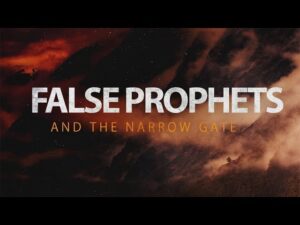What Are Tzitziyot – Part 1
Message recorded live on

What Are Tzitziyot – Part 1

Matthew Vander Els from Founded in Truth Fellowship begins a teaching on a significant topic: tzitziyot. He acknowledges that while many may have some familiarity with these tassels, his own 13 years of research have revealed deeper understandings through history, archaeology, and anthropology. This teaching aims to explore what tzitziyot are, drawing upon various scholarly sources.
The foundational understanding of tzitziyot comes from the biblical commandment given to the children of Israel to wear these small tassels on their garments. Many teachings have already covered the premise of God commanding Israel to wear these dangling fringes on their clothing. The commandment itself is found in Numbers chapter 15, starting in verse 37: “And the Lord said to Moses, ‘Speak to the Israelites, speak to the children of Israel, and tell them to make fringes on the corners of their garments throughout their generations.'” This command was not just for that generation but for all future generations. The word used here for the children of Israel, “bene Yisrael,” consistently refers to all of them without specific divisions for age or gender. The instruction is for all the children of Israel to wear these tassels, which include a thread of blue.
A modern representation of these tassels can be seen today in Judaism, particularly among the Orthodox, as well as among many Messianic and Hebrew roots believers. These tassels are typically worn on the four corners of a garment, such as a tallit katan (a small four-cornered garment) or a tallit gadol (a prayer shawl). The tassels are often white with specific knots and meanings, but crucially, they include a blue cord, in an attempt to fulfill the biblical commandment.
The commandment is repeated in Deuteronomy chapter 22 verse 12: “You shall make tassels on the four corners of your clothing with which you cover yourself.” Interestingly, the Hebrew word for tassels used in Deuteronomy is “kanaph,” which often translates to “hem” or even “wing,” suggesting that the tassel is an extension of the hem of the garment. The Hebrew word “tzitzit” itself, used in Numbers, literally means a tassel, a hanging lock of hair, or fringed edges on a garment. This word appears only three times in Scripture: twice in Numbers 15:38-39 and once in Ezekiel 8:3, possibly in the context of a lock of hair.
The crucial question then arises: why did God command Israel to wear these tassels? Looking back at Numbers 15:39, the purpose is revealed: “…that you may look upon it and remember all the commandments of the Lord and do them, and that you may not follow the harlotry to which your own heart and your own eyes are inclined, and that you may remember and do all my commandments.” Therefore, the act of looking at the tassels was intended to serve as a constant reminder of God’s sovereignty, His kingdom, and His commandments, guiding believers to obedience and away from their own sinful inclinations.
This concept can be likened to the WWJD (What Would Jesus Do) bracelets popular in the 1990s. These bracelets served as visual cues to prompt believers to consider their actions in light of their faith. In the same way, tzitziyot are presented as the biblical equivalent of WWJD bracelets. God intended for those who follow Him to wear these tassels, and every time they look at them, they would be reminded of their responsibilities within His kingdom.
The speaker emphasizes that wearing tzitziyot is like wearing the jersey of the king. In the same way that a sports jersey signifies which team a player belongs to and the expectations that come with that allegiance, tzitziyot were intended to show the world that the wearer belongs to God’s kingdom and that He is their king. This “kosher clothing” was a commandment for Israel, signifying their unique identity and their relationship with God.
To gain a deeper understanding of this practice, the teaching delves into comparative research, examining the cultures surrounding ancient Israel, such as Egypt, Mesopotamia, and others within the same historical period. This approach can provide valuable insights into why Israel was commanded to do certain things. A key quote from John Walton highlights that while the Bible was written for us, it was initially written to an ancient culture thousands of years ago, addressing things they understood within their cultural context. Therefore, understanding the cultural significance of tassels in the ancient Near East is crucial.
To find more Bible Teachings, click the link.
Application for Everyday Life:
- Remember God’s Commandments: The tzitziyot serve as a visual reminder throughout the day to be mindful of God’s laws and principles.
- Represent God’s Kingdom: Wearing tzitziyot is a public declaration of belonging to God’s kingdom, akin to wearing a team jersey, and calls for behavior that reflects His values.
- Avoid Sinful Inclinations: Looking at the tzitziyot can help redirect thoughts and actions away from desires that are contrary to God’s will.
- Embrace Equality in Christ: The historical context of tzitziyot reminds believers that in God’s kingdom, all are elevated and equal in status as His children.
- Dedicate Your Life to God: The attachment of the tassels to the hem symbolizes that all aspects of one’s life and being belong to God and should be used for His purposes.
- Reflect on Your Actions: The visual cue of the tzitziyot can prompt moments of self-assessment: “Am I living in a way that honors God and furthers His kingdom?”
References:
- Numbers 15:37 https://biblehub.com/numbers/15-37.htm
- Numbers 15:38 https://biblehub.com/numbers/15-38.htm
- Numbers 15:39 https://biblehub.com/numbers/15-39.htm
- Deuteronomy 22:12 https://biblehub.com/deuteronomy/22-12.htm
Books and Resources Mentioned:
- Of Hymns and Tassels by Jacob Milgram: Search on Amazon
- Ancient Near Eastern Thought and the Old Testament by John Walton: Search on Amazon
- The JPS Commentary of the Book of Numbers by Jacob Milgram: Search on Amazon
- The Status of Women Reflected in the Newsy Tablets by Cyrus Gordon: Search on Amazon
About Founded in Truth Fellowship
Founded in Truth Fellowship is a Messianic Fellowship in Rock Hill, SC that provides Biblical teachings, fellowship, and resources for Biblical studies. Founded in Truth Fellowship is able to spread the gospel and the word of Yeshua because of supporters like you. If Founded in Truth has been a blessing to you or your family, we ask that you would give so that the same messages can bless others.
To give to Founded in Truth Fellowship, click this link: Give to Founded in Truth Fellowship
Founded in Truth Fellowship, 1689 Springsteen Rd, Rock Hill, SC 29730 | (803) 627-8623
Visit our website: https://foundedintruth.com


